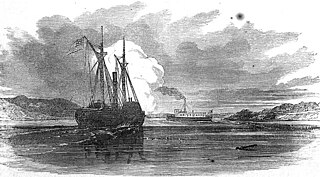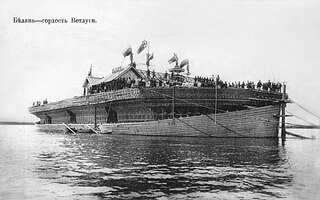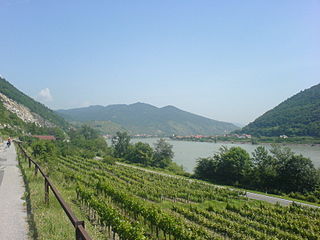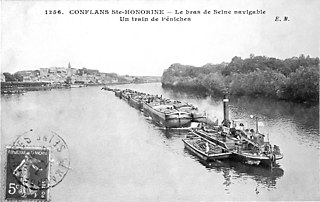
Regensburg is a city in eastern Bavaria, at the confluence of the Danube, Naab and Regen rivers, Danube's northernmost point. It is the capital of the Upper Palatinate subregion of the state in the south of Germany. With more than 150,000 inhabitants, Regensburg is the fourth-largest city in the State of Bavaria after Munich, Nuremberg and Augsburg. From its foundation as an imperial Roman river fort, the city has been the political, economic and cultural centre of the surrounding region; it is still known in the Romance languages as a cognate of its Latin name of Ratisbona. Later, under the rule of the Holy Roman Empire, it housed the Perpetual Diet of Regensburg.

A tugboat or tug is a marine vessel that manoeuvres other vessels by pushing or pulling them, with direct contact or a tow line. These boats typically tug ships in circumstances where they cannot or should not move under their own power, such as in crowded harbors or narrow canals, or cannot move at all, such as barges, disabled ships, log rafts, or oil platforms. Some are ocean-going, and some are icebreakers or salvage tugs. Early models were powered by steam engines, which were later superseded by diesel engines. Many have deluge gun water jets, which help in firefighting, especially in harbours.

The Rhine–Main–Danube Canal, is a canal in Bavaria, Germany. Connecting the Main and the Danube rivers across the European Watershed, it runs from Bamberg via Nuremberg to Kelheim. The canal connects the North Sea and Atlantic Ocean to the Black Sea, providing a navigable artery between the Rhine delta, and the Danube Delta in south-eastern Romania and south-western Ukraine. The present canal was completed in 1992 and is 171 kilometres (106 mi) long.

A disposable ship, also called raft ship, timber ship, or timber drogher is a ship or sea vessel that is intended for use on a single voyage. At the final destination, the vessel is broken up for sale or reuse of materials. Until the end of the 19th century, such ships were common on major rivers such as the Danube and the Rhine in Central Europe and the Mississippi in North America. There were also saltwater vessels that were primarily built for one-time sailing to break up. Some of the largest wooden ships in history were of this type.

The Port of Bratislava is a major port on the river Danube and — in a wider sense — on the Rhine-Main-Danube waterway, located in Bratislava, the capital of Slovakia. It is a universal inland port consisting of two parts, a cargo port and a passenger port. The former is a key facility for Slovakia's economy as the largest of three international ports in Slovakia, the others being in Komárno and Štúrovo. The port lies at the strategic intersection of the Rhine-Main-Danube Canal with the Baltic-Adriatic Corridor, part of the Trans-European Transport Networks, and it is located near two major ports: Port of Vienna and Port of Budapest.

EuroVelo 6 (EV6), named the "Rivers Route", is a EuroVelo long-distance cycling route that runs along 3,653 km (2,270 mi) some of Europe's major rivers, including much of the Loire, some of the Saône, a short section of the upper Rhine and almost the entire length of Europe’s second longest river, the Danube — from the Atlantic coast of France to the city of Constanța on the Black Sea.
The Brooklyn Eastern District Terminal was a shortline railroad and marine terminal with its main facilities and administrative offices located on 86–88 Kent Avenue in the Williamsburg section of Brooklyn, New York City.

A ship mill, more commonly known as a boat mill, is a type of watermill. The milling and grinding technology and the drive (waterwheel) are built on a floating platform on this type of mill. Its first recorded use dates back to mid-6th century AD Italy.

The Danube is the second-longest river in Europe, after the Volga in Russia. It flows through much of Central and Southeastern Europe, from the Black Forest south into the Black Sea. A large and historically important river, it was once a frontier of the Roman Empire. In the 21st century, it connects ten European countries, running through their territories or marking a border. Originating in Germany, the Danube flows southeast for 2,850 km (1,770 mi), passing through or bordering Austria, Slovakia, Hungary, Croatia, Serbia, Romania, Bulgaria, Moldova, and Ukraine. Among the many cities on the river are four national capitals: Vienna, Bratislava, Budapest, and Belgrade. Its drainage basin amounts to 817,000 km² and extends into nine more countries.

For a long time, it was not necessary to build a Harbour in Vienna, because the existing natural landing points were sufficient for the level of trade on the Danube. It was only when steamships began to arrive in great numbers that a harbour offering safe berths became essential. Even then however, goods were for the most part loaded and unloaded at an unenclosed river harbour that was established at the end of the 19th century.

Chain-boat navigation or chain-ship navigation is a little-known chapter in the history of shipping on European rivers. From around the middle of the 19th century, vessels called chain boats were used to haul strings of barges upstream by using a fixed chain lying on the bed of a river. The chain was raised from the riverbed to pass over the deck of the steamer, being hauled by a heavy winch powered by a steam engine. A variety of companies operated chain boat services on rivers such as the Elbe, Rhine, Neckar, Main, Saale, Havel, Spree and Saône as well as other rivers in Belgium and the Netherlands. Chain boats were also used in the United States.
Icebreaker Eisvogel is an icebreaker employed by the Port of Vienna, Austria. Eisvogel clears ice in all three of Vienna's harbors. She is employed when the ice becomes a few centimetres in thickness. In 1985 she cleared ice that was 60 centimetres (24 in) thick.

The New Danube is a side channel built in 1972–88 on the eastern side of the Danube in Vienna, Austria. It was created to provide flood relief by containing excess water. The Donauinsel, made out of the removed material, separates the new waterway from the main channel of the river. The project was referred to by the United Nations Human Settlements Programme (UN-HABITAT) as "the first truly multipurpose fully sustainable flood protection scheme."

Mayflower is a steam tug built in Bristol in 1861 and now preserved by Bristol Museums Galleries & Archives. She is based in Bristol Harbour at M Shed. She is the oldest Bristol-built ship afloat, and is believed to be the oldest surviving tug in the world.

The Stone Bridge in Regensburg, Germany, is a 12th-century bridge across the Danube linking the Old Town with Stadtamhof. For more than 800 years, until the 1930s, it was the city's only bridge across the river. It is a masterwork of medieval construction and an emblem of the city.

SMS Leitha or Lajta Monitor Museumship was the first river monitor in Europe and the oldest and also the only remaining, fully restored warship of the Austro-Hungarian Navy. Currently it is moored on the Danube in Budapest near the Hungarian Parliament Building as a museum ship.

Vardar was a Sava-class river monitor built for the Austro-Hungarian Navy as SMS Bosna, but was renamed SMS Temes (II) before she went into service. During World War I, she was the flagship of the Danube Flotilla, and fought the Serbian Army, the Romanian Navy and Army, and the French Army. She reverted to the name Bosna in May 1917, after the original SMS Temes was raised and returned to service. After brief service with the Hungarian People's Republic at the end of the war, she was transferred to the newly created Kingdom of Serbs, Croats and Slovenes, and renamed Vardar. She remained in service throughout the interwar period, although budget restrictions meant she was not always in full commission.

SMS Körös was the name ship of the Körös-class river monitors built for the Austro-Hungarian Navy. Completed in 1892, the ship was part of the Danube Flotilla, and fought various Allied forces from Belgrade down the Danube to the Black Sea during World War I. After brief service with the Hungarian People's Republic at the end of the war, she was transferred to the newly created Kingdom of Serbs, Croats, and Slovenes, and renamed Morava. She remained in service throughout the interwar period, although budget restrictions meant she was not always in full commission.
Ukrainian Danube Shipping Company is a Ukrainian shipping company that specializes in water transportation along the Danube and Black Sea.
MV Omskiy-205 is a Russian Omskiy type general cargo ship launched in 1993 by Krasnoyarsk Shipyard. It was damaged while underway during the 2022 Russian invasion of Ukraine, possibly by a Russian mine.
















